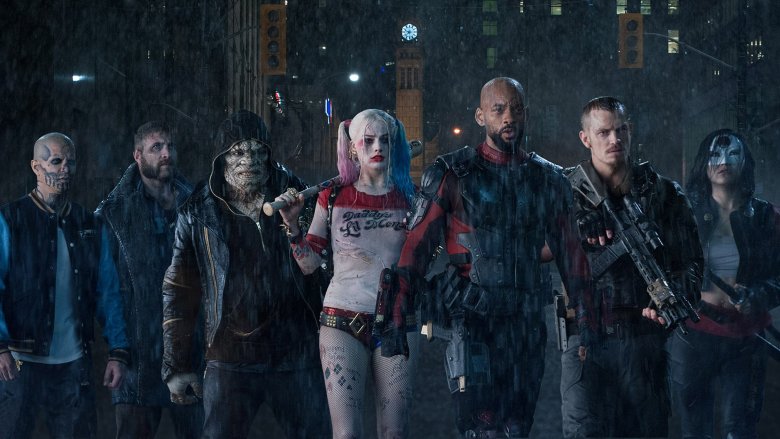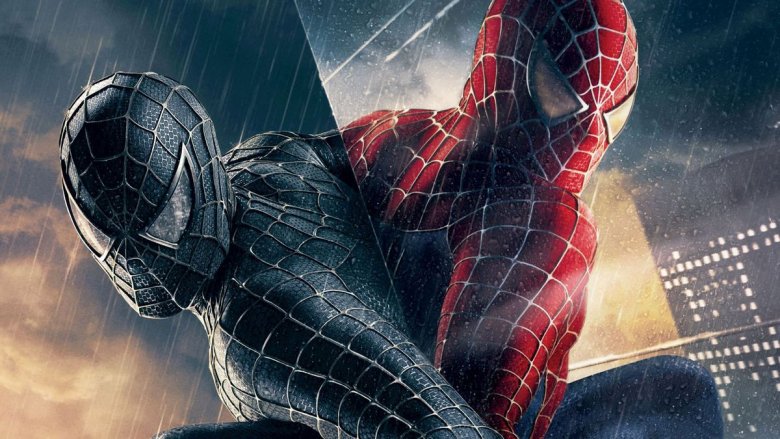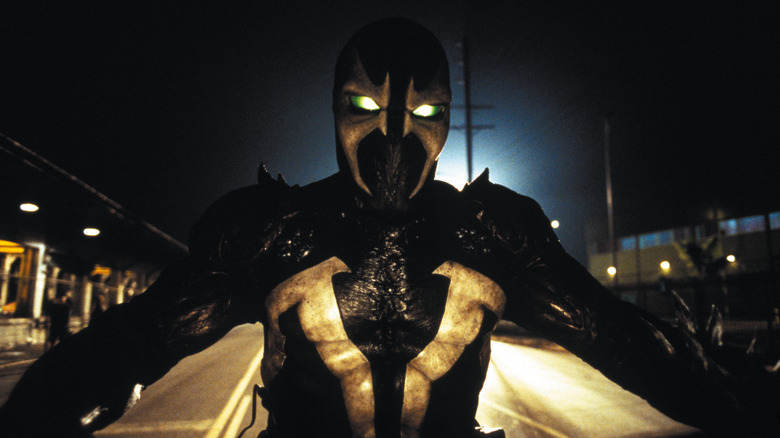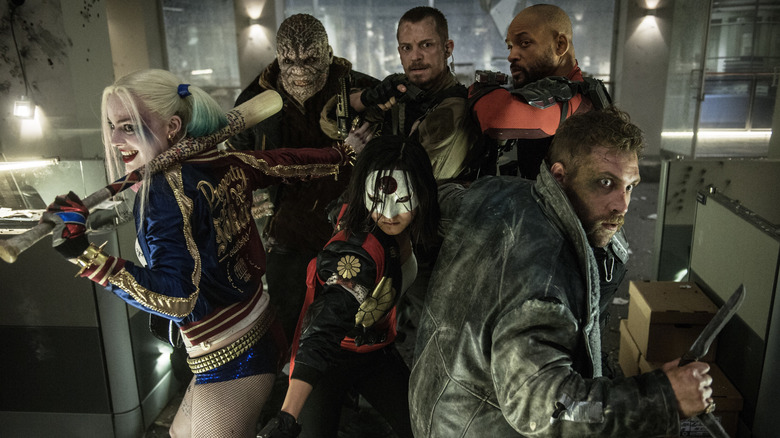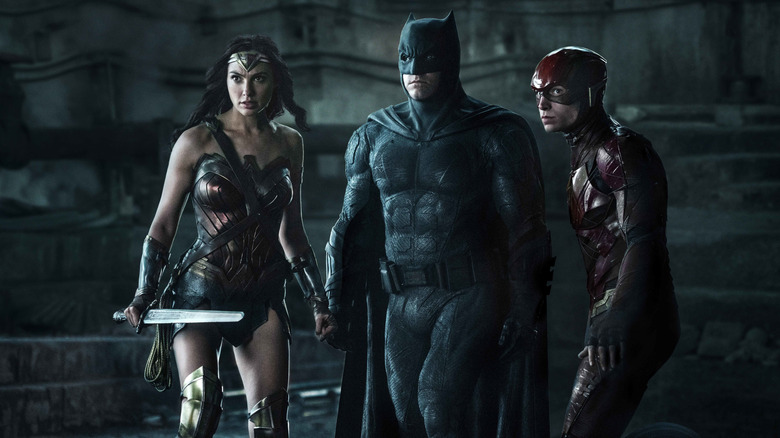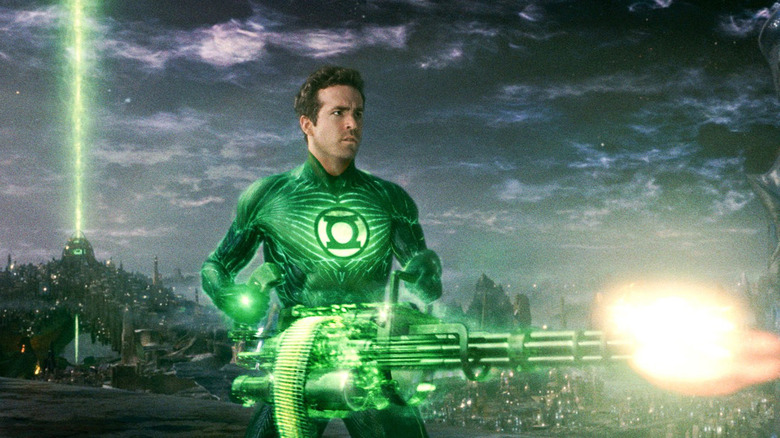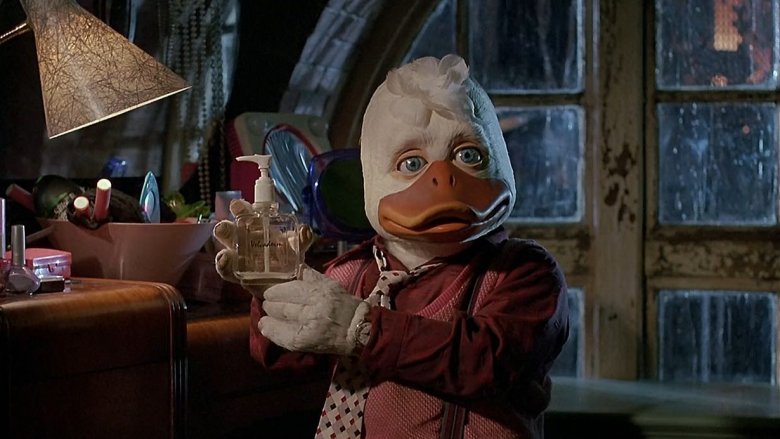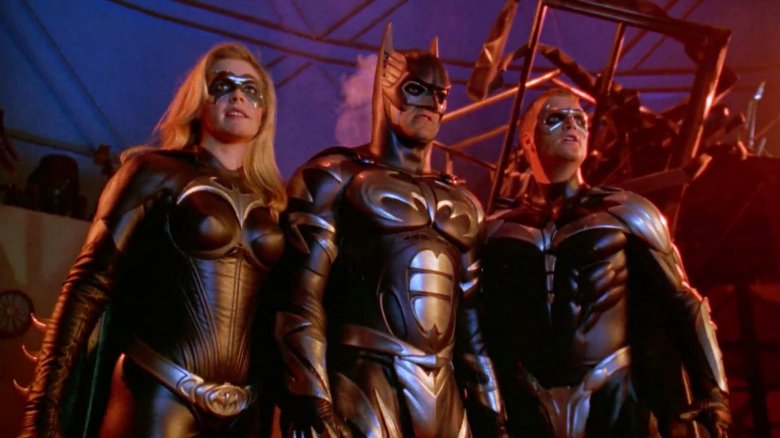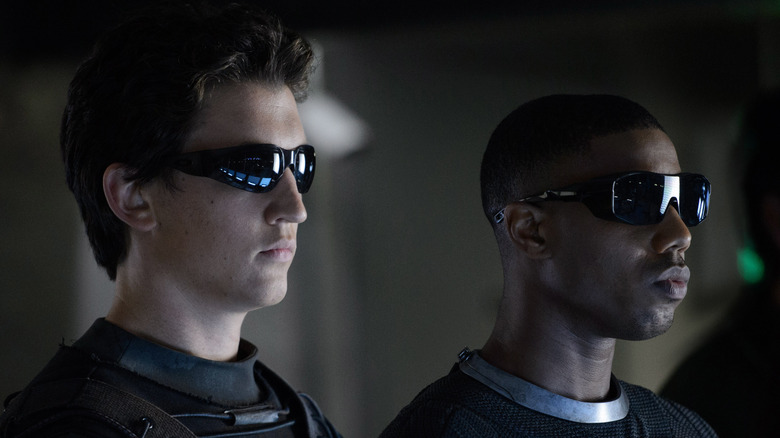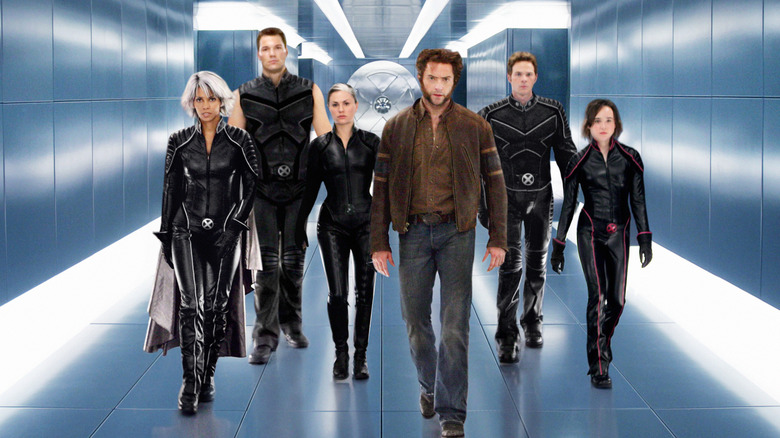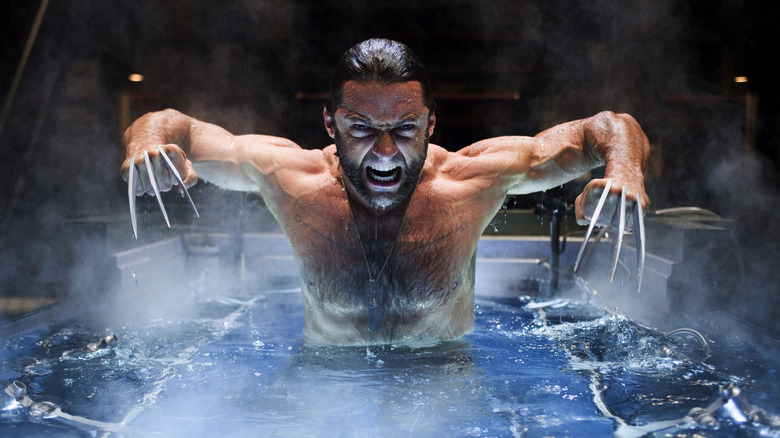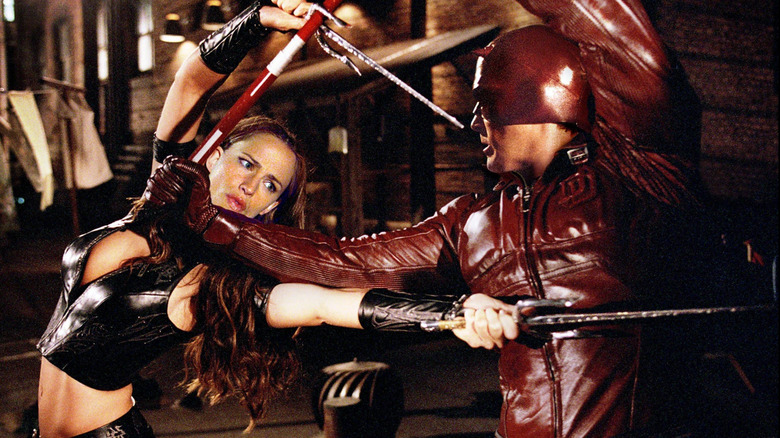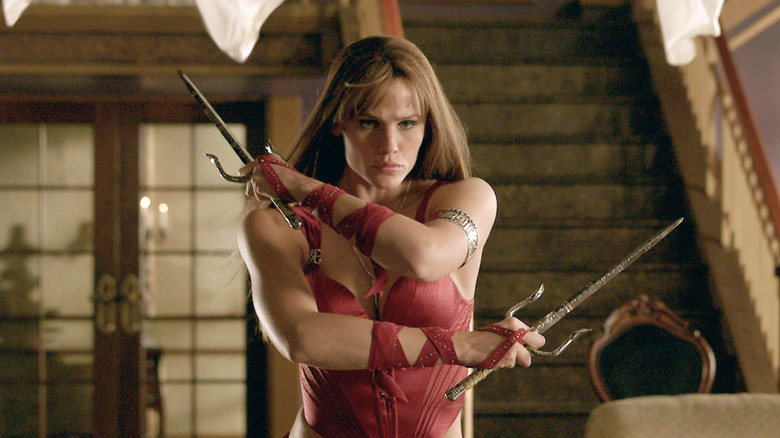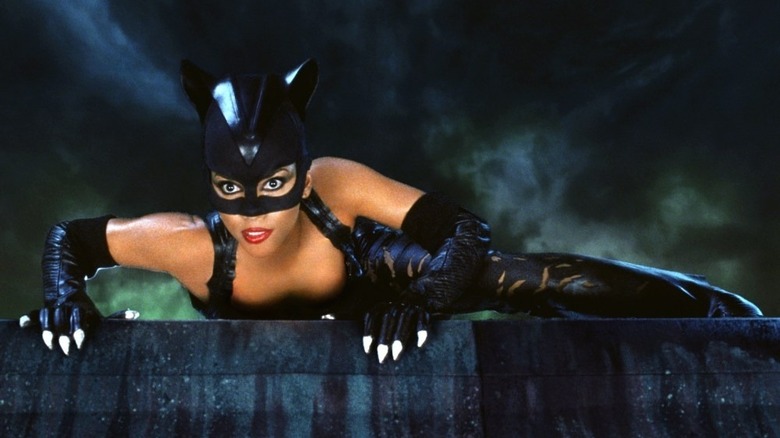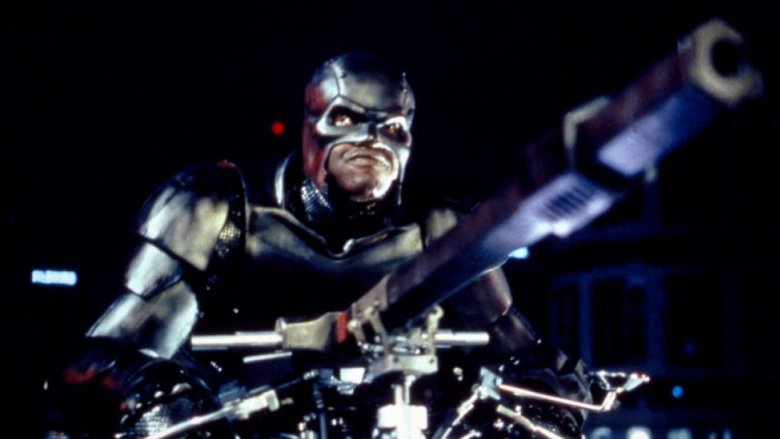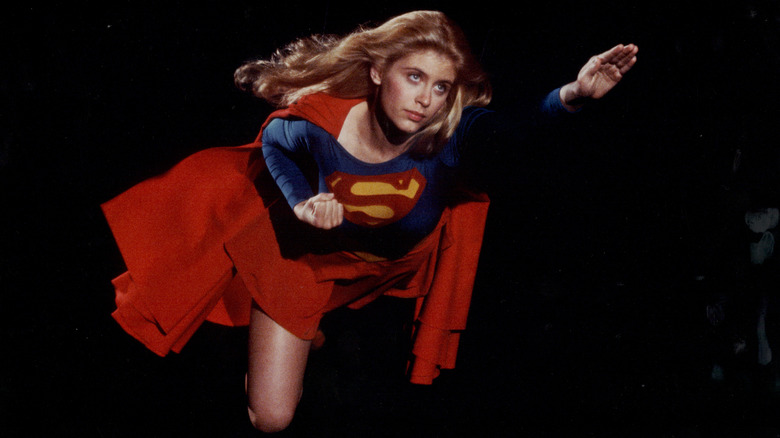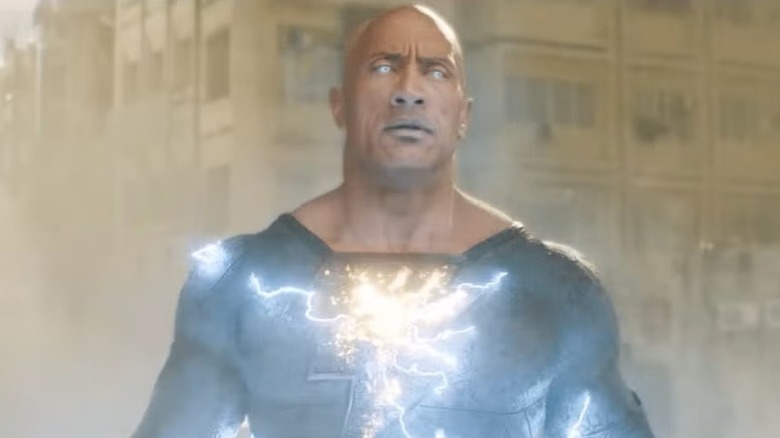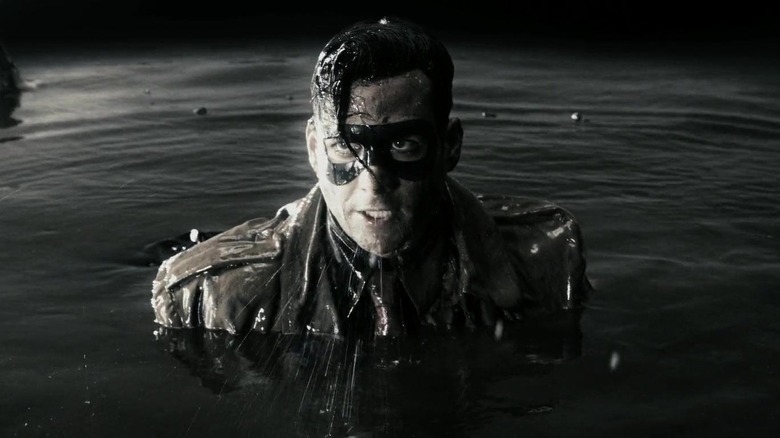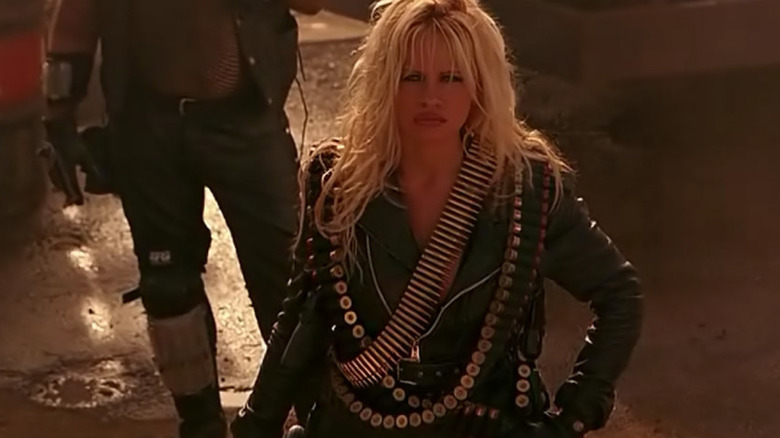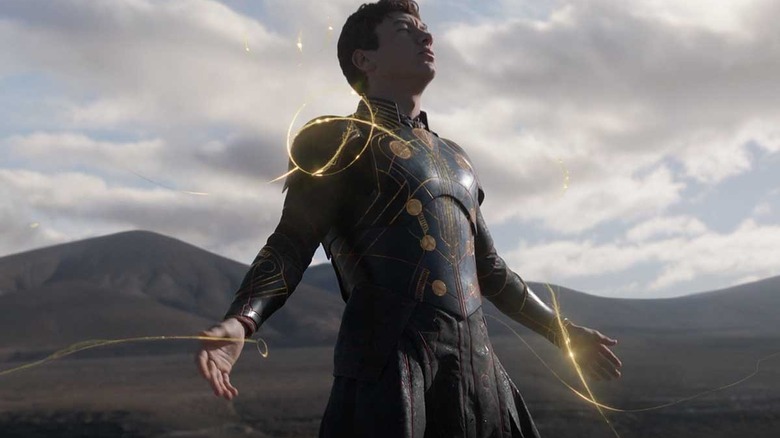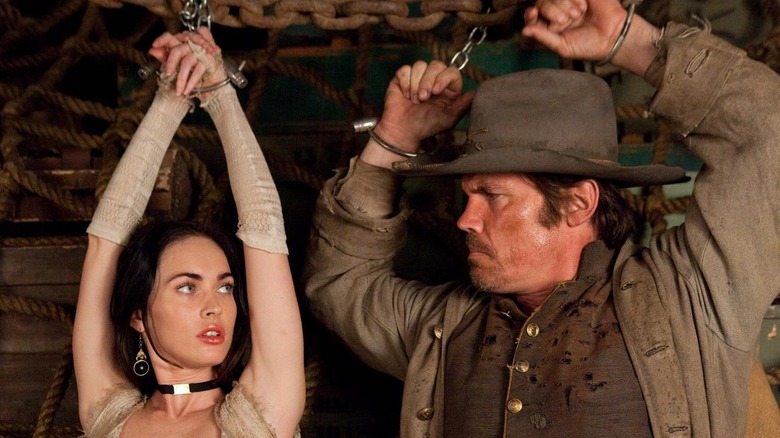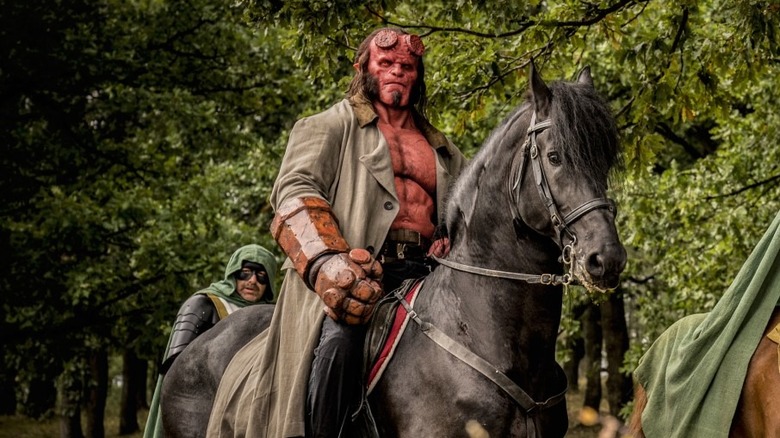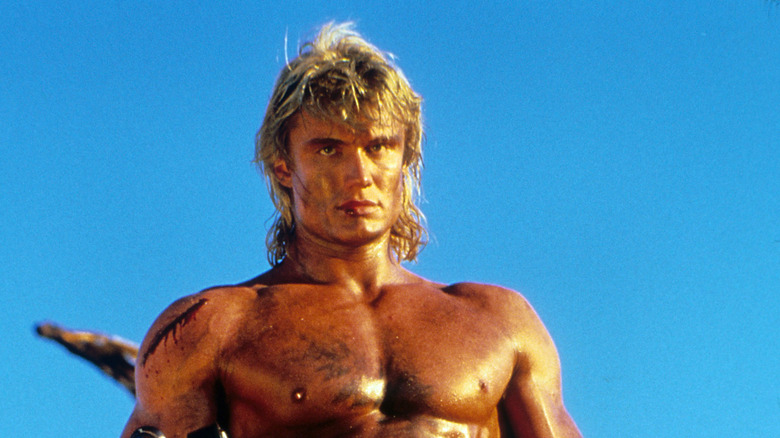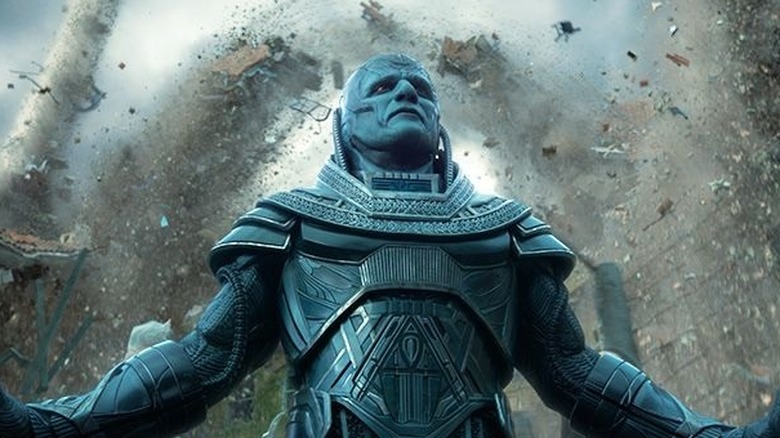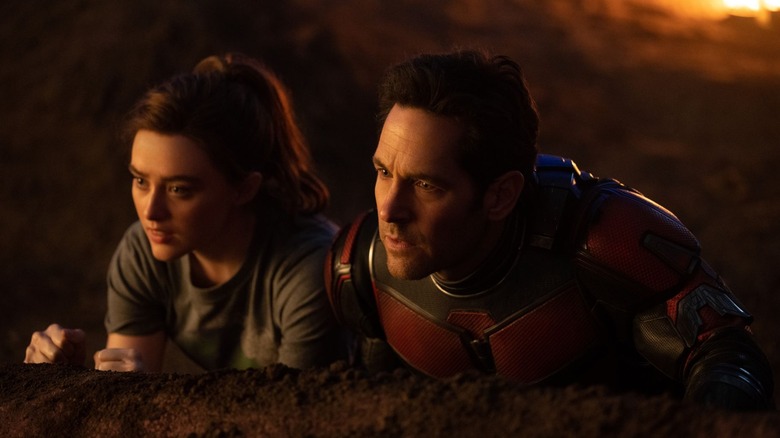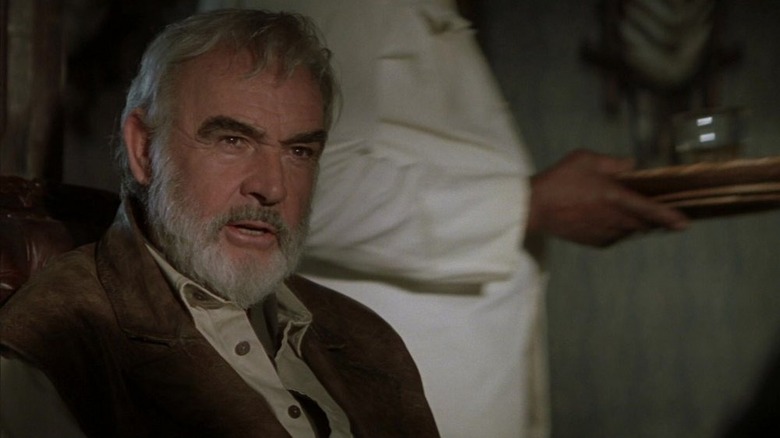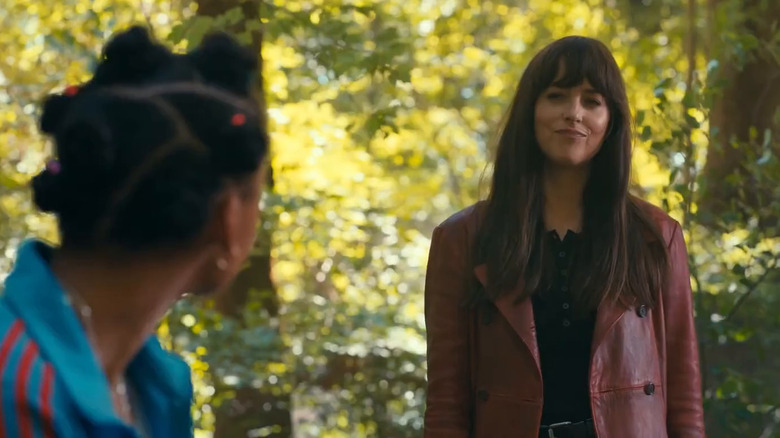Overhyped Superhero Movies That Ended Up Being Terrible
We live in divisive times, but we can all agree on one thing: superhero movies? Pretty dope. Through magic or science or (probably) the combined efforts of hundreds of dedicated, talented people, films about comic book characters have become consistently entertaining, frequently awe-inspiring spectacles of storytelling and CGI light thingies coming out of people's hands. Because of this, the last decade has seen an enormous shift in Hollywood's power dynamic, often revolving around the question of who owns the rights to which costumed vigilantes.
With movies like "Avengers: Endgame" and "Captain Marvel" breaking records at the box office and receiving critical acclaim, it can be easy to forget that there was a time when superhero flicks were a dangerously uncertain bet for studios. A time as far back as, like, 2017. As great as the onscreen tales of America's mythology have become, a lot of the time, they let us down hard. Here's a look at some of the worst offenders.
Spider-Man 3
"Spider-Man 3": the sequel that launched a thousand dancing Peter memes. The film that exposed Peter Parker's dark side, a persona so vile and degenerate as to border on just being kind of a jazz club dweeb. A movie that looked at its predecessors' careful explorations of their villains' psyches and bravely asked, "What if we didn't do that this time?"
In today's climate, it can seem like a superhero movie doesn't really "count" unless there's a crossover cameo and the looming promise of a hundred sequels. It can be easy to forget that the relatively self-contained Sam Raimi "Spider-Man" films were some of the most popular movies of their time. Along with "X-Men," 2002's "Spider-Man" is credited with starting the modern comic book movie boom. The first two installments grossed over $1.5 billion and received rave reviews. When the time came for the inevitable followup, expectations were high, and so was the budget, which rocketed to an estimated $258 million. What resulted was the highest-grossing movie of the year, but a bummer for the fans.
Spawn
It's inexplicable looking back, but there was a time when studios seemed convinced that semi-obscure independent comic book characters were a better draw than the ones everybody recognized. While filmmakers like Tim Burton and Kevin Smith failed to get a new Superman movie off the ground, pictures like "Judge Dredd," "The Mask," and "The Phantom" came out with astonishing regularity.
Without a doubt, "Spawn" was the one to beat in 1997. It featured an iconic '90s anti-hero and all the grisly action you could shake a hellfire-engulfed chain at. Plus, what else was coming out that year? A movie about a boat sinking? Nah, "Spawn" was going to dominate.
And dominate it didn't. The movie was poorly received. Its pioneering use of CGI looked corny, its writing was abysmal, and all of the scenes featuring the Violator stank of the director clapping and guffawing while he let John Leguizamo do whatever he wanted. There's also a shockingly enormous amount of fart humor for an R-rated trip to the theater. A planned sequel was put on the back burner, then left there.
Still, superheroes never really die, especially not the ones who are already dead. A Jamie Foxx-led reboot is currently in the works.
Suicide Squad
Nobody here is going to accuse DC of totally aping Marvel when they made "Suicide Squad." All we're saying is that in 2014, Marvel released "Guardians of the Galaxy," a colorful story with a classic rock soundtrack about a zany ensemble of morally ambiguous B-listers, and then two years later, Captain Boomerang and Killer Croc were chewing scenery backed by "Bohemian Rhapsody" and ... you know what? They aped it. We are saying that.
And it wouldn't have been so bad if everything had gone more smoothly. DC was coming off of a decade of bleak movies, and a little levity might've been the shot in the arm that their cinematic universe needed. Unfortunately for the fans, what made it to the screen was sort of a sticky mess. The characters don't come together. If a picture is worth a thousand words, the script to SS is what would happen if you wrote out an amateur Garbage Pail Kids knockoff. The climactic bad guy looked like microwaved Gak. Jared Leto's much-publicized new Joker stuck around for all of about eight minutes before disappearing, maybe forever, to go be Morbius the Living Vampire for Sony/Marvel.
In the end, the greatest contribution the movie made to the public consciousness was giving young people a valuable lesson in the importance of not wearing short shorts in October, thanks to Spirit Halloween's line of Harley Quinn costumes.
Batman v Superman: Dawn of Justice
Remember that show "Deadliest Warrior?" They'd take two iconic fighters from history and pit them against each other in a hypothetical battle royale. If it was playing at the right bar, you could almost always find a guy in the corner who took the show way too seriously, graphically describing how the fight should've gone and generally skeeving out everybody else in the room. Basically, if that guy got to make his own superhero movie, it would've been "Batman v Superman: Dawn of Justice."
Drawing visual inspiration from Frank Miller's "The Dark Knight Returns" and dramatic inspiration, seemingly, from internet fan fiction that a troubled 14-year-old wrote after reading Frank Miller's "The Dark Knight Returns," "Batman v Superman: Dawn of Justice" was the better part of a century in the making. It was the first big screen, big budget attempt to bring two of American fiction's most iconic characters together.
Thanks to a script that felt like whatever comes before the first draft and a tone that was less Nolan-esque and more of a two-and-a-half-hour video game cutscene, what should've been a portrayal of light versus dark and hope versus cynicism landed more like the story of what happens when your childhood heroes try bath salts and get real mad.
Justice League
So... then they made a sequel.
"Justice League" was supposed to be DC's answer to Marvel's "Avengers" series. At last, the only powerhouse comic book publisher with the wherewithal to stand up to Stan Lee's towering nonagenarian frame was going to take their place on the Fields of Box Office Glory. Batman. Wonder Woman. The Flash. Even a sexed-up Aquaman that looked like a Jurassic Park scientist infused Jack Sparrow with Tom Hardy DNA. Darn it all, they couldn't miss ... unless something went horribly wrong.
A couple of horribly wrong things later, we got "Justice League." The production was plagued by high-profile problems. Director Zack Snyder left the movie after the death of his daughter, and "Avengers" frontman Joss Whedon was brought on to finish the project. Extensive reshoots and the world's most famous invisible mustache begat one of the most expensive movies ever made; a highly-stylized trolley car accident of a film that, against all odds, managed to make over $650 million worldwide and still lose money.
Green Lantern
Sit now, children, and listen to the elders as they tell you of a time before anyone was really sure that Ryan Reynolds could be in a superhero movie that didn't suck like a car wash vacuum hose.
It was the summer of 2011. Marvel was rounding the corner on "The Avengers" and DC had dollar signs in their eyes. With Christopher Nolan at the tail end of his Batman series, it was time to start building an onscreen Justice League. And what better place to start than with the most visually complicated and thematically ridiculous characters on their roster, the Green Lantern Corps?
Ryan Reynolds gave a charming performance as Hal Jordan. Everything else was what would happen if someone made a bomb out of CGI and dropped it on a unitard factory. The script introduces us to a cocky showoff fighter pilot and then expects us to accept that he doesn't want brightly colored showboat superpowers. The bad guy looks like evil jam.
Luckily, five years later, Reynolds' pool wound up dead and he leveraged that into some success.
Howard the Duck
Decades before Marvel Studios and Lucasfilm moved into Disney's basement, they briefly roomed together when George Lucas had the visionary plan to produce the first-ever theatrically-released Marvel movie. Which character did the mind behind "Star Wars" choose for this endeavor? It's difficult to spell out the sound of a heavy, exhausted sigh followed by the sound of cheap whiskey being swallowed, but if we could we'd put that here.
Look, it can be easy to forget that Howard the Duck was a pretty outstanding character. His Marvel stories have always been subversive and weird and over the top and a lot of the time, super gross. Since his first cameo in a Conan-adjacent swords-and-sorcery story in 1973, he's been pointing out how little sense the comic book world makes, and doing it from the body of a cartoon water fowl.
Anyway, the movie came along and stunted any hopes of an MCU by making Marvel's premiere big screen character sort of a horned-up, feathery E.T., with an inexplicable blend of kid humor and duck condoms. Anthropologists in the year 3000 will ruin their marriages with all of the late nights at the lab spent trying to figure out who this movie was for.
Batman and Robin
First, there was "Batman," Tim Burton's dark, stylized reintroduction to the Dark Knight. The world fell in love. Then, there was "Batman Returns," Tim Burton's ever darker, even more stylized follow up. The world said, "Maybe Danny DeVito vomiting inky blood is a little much. You know, we brought our kids to this. Let's let someone else drive."
Next, there was "Batman Forever," Joel Schumacher's significantly less dark but somehow more stylized attempt to get the series back on a more family friendly track, and the world said, "Okay, but now it seems like we're overcorrecting? Just a little?" And finally, there was "Batman and Robin," Joel Schumacher's visual representation of what happens when a garage sale Rubbermaid container full of action figures all try molly at the same time.
It had glow sticks. It had Arnold Schwarzenegger. It had the inexplicable addition of automatic ice skates to the Dynamic Duo's everyday going-out boots. Perhaps most baffling of all, it had Coolio, and somehow he was the only person in the movie to not make a cold-related pun.
Fant4stic
Spider-Man is Amazing more often than not, the Hulk finally got around to being Incredible, but it's so hard to make a movie about the Four come out Fantastic. After director Tim Story took a couple of cracks at fun, family adventures utilizing Marvel's First Family, Fox saw fit to hand the franchise to indie darling Josh Trank.
What happened next is hard to say. Trank says that he put together a cut of the movie that he was proud of and then the studio took the project from him. The studio said that Trank threw a bevy of temper tantrums, fought with the actors, and mismanaged the entire production. Stan Lee probably said "Excelsior," but that would've been unrelated. It's just a thing he said a lot.
As movies go, "Fant4stic" (pronounced the way it's spelled, we assume) is a difficult one to defend. The characters are bland and the Thing doesn't wear pants, answering one decades-old question about his anatomy, but raising so many new ones. Victor Domashev Von Doom, meanwhile, looks like a crash test dummy made out of moonstone.
X-Men: The Last Stand
After the first two "X-Men" movies blockbusted superhero movies into the public eye and showed the world that comic book characters could have depth and significance, it was a little jarring when "X-Men: The Last Stand" was the follow up. All of the subtle undertones were gone, replaced by dialogue that might as well have been spoken straight into the camera and tagged with the line "Do you get it? We're a metaphor!" every time.
Beloved characters like Angel and Colossus, played up in the trailers, were relegated to glorified cameo parts to make up for the paragraphs-long list of featured players. Others, like Psylocke and Kid Omega, were more or less just names that got stuck on weird-looking mutants to give them brand recognition. Cyclops died off screen, Professor X died all over the screen, and Magneto went full mustache-twirling cartoon bad guy.
Luckily, a tepid fan response really bent the ears of the executives at 20th Century Fox, and they never made another noisy, pointless X-Men movie again ... right?
X-Men Origins: Wolverine
Just shy of three years later, 20th Century Fox released another noisy, pointless X-Men movie.
"X-Men Origins: Wolverine," the ever ill-advised answer to the question, "Hey, you know that character whose entire appeal is his mysterious past and his quest for meaning through self-actualization rather than dwelling on what used to be? What's his deal, anyway?" The film starred Hugh Jackman, Liev Schreiber, and Hugh Jackman's shirtless torso.
This is the internet, and there's not much that can be said about X-Men Origins: Wolverine that hasn't been said already. The decades-long wait for a big screen Gambit is now just another drop in the ocean of things Hollywood wishes they hadn't involved Taylor Kitsch in around that time. There's that scene where Wolverine checks out his claws in the bathroom and he looks like he has six Singing Swords from "Who Framed Roger Rabbit" coming out of his mitts. And there's the movie's take on Deadpool, which is ... not really something we talk about anymore.
Daredevil
It was 2003, and audiences were ready for a dark take on comic book stories. Fox provided, offering up "Daredevil," the tale of a guilt-ridden disabled Catholic who dresses like the devil and throws bad guys in front of trains. What could possibly go wrong?
Written and directed by Mark Steven Johnson, the mind behind both "Grumpy Old Men" films and Michael Keaton's "Jack Frost," "Daredevil" mashed together elements of a ton of popular storylines from the comics and added just a hint of overwhelming amounts of Evanescence. Ben "Not a Boy, Not Yet a Batman" Affleck played Matt Murdock, vigilante by night and guy who won't take a woman trying to punch him as a hint that she wants him to leave her alone by day. They never address it in the script, but it's a good thing for Matt that he's an attorney.
Despite having a couple of decent moments (the scene where Matt interrogates a guy by "blindly" driving his car is golden) and a director's cut that, taking a wide view, doesn't suck, "Daredevil" winds up being an impossible-to-describe smoothie of over-stylization and blandness. That said, more than 15 years later, it remains one of the few superhero films to prominently feature music by Nickelback. So... that's something.
Elektra
"Okay," thought Fox, "'Daredevil' didn't quite work. Let's not throw the baby out with the bathwater. That Jennifer Garner sure did an adequate job of flipping around and looking sad. Let's give her her own picture. Only this time, we'll do it right! We'll hire the director of 'Reign of Fire' and everything will turn out great! Right? Right, guys?"
The oft-forgotten second and final entry in Fox's Daredevil-verse reeked heavily of a development meeting where one of the executives said "there are no bad ideas" and genuinely meant it. There's ninjas and magic tattoos and Terence Stamp and honestly, probably not a lot of people who made it all the way to the end. Garner shot the whole thing while she was on a break from "Alias," and sources close to her say that she only did it because she was contractually obligated and thought the movie was trash.
Catwoman
It's a rare movie that's so universally hated that the lead performer shows up to the Golden Raspberry awards to acknowledge their wrongdoings. And "Catwoman" is nothing if not a rare movie.
See, right before Christopher and Jonathan Nolan convinced studios that maybe the secret to a good superhero movie was — and this is shocking — attaching good filmmakers, Warner Bros. released "Catwoman." It's the story of a character whose sensuality is curtailed somewhat by the realization that she probably smells like ammonia all the time. Halle Berry plays Patience Phillips, who is definitely not Michelle Pfeiffer from "Batman Returns" but follows the thematic beats of her genesis story unusually closely. Uptight working class woman? Check. Discovers corporate corruption and is murdered as a result? Check. Brought back to life when cats rub against her, presumably through the life giving powers of static electricity? You'd better believe that's a check.
And it's bad. It's so bad. Catwoman uses her newfound cat powers to shut down her neighbors' noisy party, making her come off as less Catwoman and more cat lady. It doesn't get better after that. For a candid description of the film's quality, please see Halle Berry's acceptance speech at the 2005 Razzies, which included the kind of grown-up words we can't use here.
Steel
The truth may be lost, but it still exists, whispering to us from boxed-up VHS collections and the backs of abandoned video rental stores: Shaquille O'Neal had an acting career, and he absolutely made a superhero movie.
It was 1997, and crowds had come down with a severe case of Shaq fever after his jaw-dropping turn as the titular rapping boombox genie in the hit movie "Kazaam." The thing is, "Space Jam" had just broken box office records and nobody was sure why, so maybe studios thought that wooden, dead-eyed performances from professional athletes were the lightning in a bottle they needed. Who's to say, really? The point is, we got "Steel" out of the chaos, and the world is grateful for it.
Here's the really weird thing: on paper, the plot bears striking similarities to "Iron Man." It's about a weapons designer who, after a fateful accident involving his own creations, builds a metal suit of power armor and takes down the man he used to work with who was selling their creations to the bad guys all along. It's difficult to say what factors made the two movies so contrasting in quality, besides a hundred million dollars, a decade of progress in the development of CGI, and casting actual actors.
Supergirl
These days, we take for granted that new superhero movies come out left and right, as well as having multiple films set within the same family of comics. But it was a pretty big deal when, in 1984, "Supergirl" was released as not only a spinoff to the "Superman" movies but specifically meant to take place between "Superman III" and "Superman IV: The Quest for Peace." It even shared a character — Jimmy Olsen, played in "Supergirl" by Marc McClure, reprising his role from all four "Superman" movies.
As we now know, the main "Superman" series was already on its steep quality decline by this point. "Superman II" was the last of the Christopher Reeve "Superman" movies to be universally beloved, with "Superman III" bad and "Superman IV" even worse. Unfortunately, things didn't fare any better for "Supergirl," which accomplished the seemingly impossible feat of reviewing even worse than "Superman IV" — which itself sits at a pathetic 10% on Rotten Tomatoes. In fact, "Supergirl" only has an 8%, with Roger Ebert asking in his review, "Why even go to the trouble of making a movie that feels like it's laughing at itself?"
At least star Helen Slater eventually got better Superman-adjacent material to attach a legacy to, appearing as his biological Kryptonian mother in three episodes of "Smallville" and in a recurring role as Supergirl's adoptive Earth mother in the CW's "Supergirl."
Black Adam
The DC Extended Universe was already lying in its coffin waiting for someone to take the last whack of the final nail when "Black Adam" was released. Even if the movie had been amazing, the damage had been done, and James Gunn and company were already laying the foundation for an entirely new era of DC movies. Star and producer Dwayne Johnson did his best to convince us that the movie was something truly special, and that the next iconic big screen superhero had arrived, even knowing that "Black Adam" was being released off the back end of a sinking ship.
Johnson obviously has both the charm and the action chops to play a superhero, and he is a perfectly fine Black Adam. But years of development hell are all over this film, leaving it a cobbled together mess. Even the special effects, which had previously been the one thing that could be counted on in a big budget comic book movie, were wildly uneven and bordered on amateurish in spots — which predicted similar issues in that department for the following year's "The Flash." The DCEU limped to its inevitable end the following year, with "Black Adam" doing nothing to disprove the notion that the whole endeavor was ultimately a failed experiment that had already outlived its expiration date.
The Spirit
Had "The Spirit" actually come out when it was originally supposed to — way back in the 1970s, with a script written by the original creator of the comic — it would've been released to an audience that still had nostalgia for it. Instead, it spent literally decades failing to get off the ground, with numerous seemingly promising false starts inevitably going nowhere for one reason or another.
So when it was announced that a "The Spirit" movie was finally getting made — written and directed by Frank Miller and in a similar visual style to his and Robert Rodriguez's "Sin City" film from a few years prior — expectations were obviously through the roof. But as it turned out, that visual style is just about all the movie had going for it. As the Rotten Tomatoes critical consensus laments under its 14% rating, "Though its visuals are unique, 'The Spirit”s plot is almost incomprehensible, the dialogue is ludicrously mannered, and the characters are unmemorable."
Barb Wire
The world will never be able to do enough apologizing to Pamela Anderson for the terrible way she was treated after the leak of her sex tape with then-husband Tommy Lee. Something happened to her that was incredibly invasive and traumatic, and all the media did was crack jokes about her and shame her for literally years to come — while Lee basically got high fives and a career boost over the whole thing.
"Barb Wire," the 1996 movie based on the Dark Horse character and series of the same name, was supposed to be Anderson's movie star vehicle. But the sex tape controversy loomed large over the press cycle for the movie, and any chance of it being a hit and making Anderson the next big Hollywood lead was essentially ruined. All that being said, the movie itself was pretty awful. Anderson does okay in the role, obviously looking the part but being somewhat shaky on the acting front. In her defense, though, she had nothing of value or substance to work with.
Even a top-tier actress like Charlize Theron would've struggled to transform this material into anything remotely watchable. "Barb Wire" doesn't even manage to hit the lowest common denominator of being a sexy, campy, so-bad-its-good romp, which is almost impressive in its own way.
Eternals
"Avengers: Endgame" was always going to be a tough act to follow. But even so, the Marvel Cinematic Universe still managed to close out Phase Three with the impressive victory lap that was "Spider-Man: Far From Home," leaving many hopeful that the franchise was going to be able to maintain its high quality as things rolled into Phase Four. "Black Widow," the first movie of Phase Four, wasn't amazing, but was also far from bad. But the excellent "Shang-Chi and the Legend of the Ten Rings" seemed to set the stage nicely for the third Phase Four film, the one that would introduce the first new MCU team of the post-"Endgame" era.
What we got with "Eternals" instead was the first MCU movie in history to get a rotten score on Rotten Tomatoes, and still one of only three to earn that unfortunate distinction. Even the so-called worst MCU movies up to that point, like "Thor: The Dark World" and "The Incredible Hulk," got scores comfortably in fresh territory. According to Rotten Tomatoes, the days of being able to proclaim that there aren't any truly bad MCU movies ended the day "Eternals" was released. The powers that be are seemingly so eager to keep "Eternals" in the past that none of the titular team have showed up again in any other MCU movie since.
Jonah Hex
It became apparent early on in the Marvel Cinematic Universe that things were going to be kept pretty family friendly. At the same time, DC movie adaptations were allowed to get a little more edgy, a little more wild, and a little more sexy. And with that in mind, 2010's "Jonah Hex" promised to be something of an antidote to the supposedly sanitized direction Marvel movies were going in — with the two main leads being the titular Confederate soldier bounty hunter (Josh Brolin) and his prostitute girlfriend, Lilah (Megan Fox). That it was coming courtesy of the screenwriting team behind gleefully outrageous cult hit "Crank" was reason to be excited indeed.
The warning signs were there that "Jonah Hex" wasn't going to deliver on what it was promising. While promoting the film, Brolin thought the thing to say to MTV was, "When I first read it I thought, oh my God it's awful! And then I had a moment a week later and I thought why is it awful? Maybe the thing to do is to do the most awful movie I can find." Um, okay. Meanwhile, that previously mentioned screenwriting team was also supposed to direct, but they left the project due to creative differences. The A.V. Club gave it an F. Rolling Stone ranked it even lower than the infamously terrible "The Last Airbender" in its list of the worst movies of 2010. And at the box office, it just barely cracked $10 million.
So what is Mr. Brolin saying about "Jonah Hex" these days? He told GQ in 2024, "I won't ever stop s**ting on 'Jonah Hex' because it was a s**ty f***ing movie!" Enough said.
Hellboy (2019)
The mid-2000s were a weird time for superhero movies. You had "X2," "Batman Begins" and "Spider-Man 2" bringing the genre to a level of high-brow respectability it hadn't had in years — if ever. But at the same time, it also saw disappointing entries like "Fantastic Four" and "Ghost Rider" that led to a real one step forward, two steps back situation. In the midst of all that was 2004's "Hellboy," which came out of nowhere to become one of the biggest sleeper hit comic book films of the decade. It then pulled off the tricky feat of a follow up in 2008 that was even better.
Writer/director Guillermo Del Toro already had designs on a trilogy before he even finished "Hellboy II: The Golden Army," but those plans sadly fell through. And then the franchise went dormant for a decade before being revived for 2019's "Hellboy." That it was loosely built on the foundation of the unmade third Del Toro film definitely piqued a lot more interest than it might have otherwise. The first footage shown at ComicCon seemed to suggest a project heading in the right direction, and excitement rose even higher.
Fast forward to the end product, which not only managed a mere 17% critics' score on Rotten Tomatoes, but even the Popcornmeter couldn't crack 50%. It ended up being one of the biggest box office bombs of the year.
Masters of the Universe
Long before the "Transformers" live action movies were earning billions of dollars at the box office and "Barbie" got nominated for a best picture Oscar, there was a lot of trial and error by toy companies in how to find success on the big screen. Initially, it was assumed that animation was the best way to go, resulting in early efforts like "My Little Pony: The Movie," "G.I. Joe: The Movie," "Transformers: The Movie," and so on. And the general consensus was that the movies should also be aimed at young children — which made sense, since these were all properties based on toys.
Kids don't stay kids forever, though, which was a thought clearly had by the people who set about making a "Masters of the Universe" movie in 1987. It was not only live action — with Dolph Lundgren as He-Man — but a little darker and scarier than the average movie based on a toy. Those who had played with He-Man toys, watched the He-Man cartoon, and read the He-Man comics were at the age to enjoy a movie that took the source material a little bit more seriously. Production company Cannon Films promised big things with "Masters of the Universe," even going so far as to liken it to being the "Star Wars" of its era when promoting it.
It wasn't even the "Star Wars" of its opening weekend, finishing only third place at the box office. Critics praised the delightfully campy performance of Frank Langella as Skeletor — and absolutely nothing else.
X-Men: Apocalypse
After the one-two disappointment punch of "X-Men: The Last Stand" and "X-Men Origins: Wolverine," things were looking pretty dire for Marvel's mutants under the 20th Century Fox banner. But 2011's "X-Men: First Class" put on a clinic in how to course-correct a floundering superhero franchise. It was so well received, in fact, that Fox felt emboldened to let the franchise take on one of the most iconic stories in X-Men history with follow-up "X-Men: Days of Future Past." And, remarkably, they nailed it. Between that and the major turnaround the solo Wolverine movies got with "The Wolverine," the X-Men movie franchise was suddenly a force to be reckoned with again.
By this point in the Marvel Cinematic Universe, things were building toward the epic showdown with Thanos. So the "X-Men" movies felt they needed to follow suit by having Apocalypse come into the picture, to give that series its own all-in battle against a seemingly unbeatable big bad. Confidence was high that they'd pull it off given the streak that the "X-Men" franchise had been. And that confidence ended up being entirely misplaced, as "X-Men: Apocalypse" was, as Scott Mendelson of Forbes described it, "a franchise-killing disaster." Perhaps even more damning was the review from Jen Yamato of The Daily Beast, who says "Apocalypse" was a contender for worst "X-Men" movie up to that point — and that's saying something.
"Dark Phoenix" came next, which was somehow even worse. But after "Apocalypse," nobody was expecting too much from it anyway.
Ant-Man and the Wasp: Quantumania
"Eternals" only had to spend two years with the dishonor of being the only Marvel Cinematic Universe movie with a rotten score: In 2023, "Ant-Man and the Wasp: Quantumania" was released, and joined that sad club. While MCU's Phase Four had some shaky moments, it did end with the excellent "Black Panther: Wakanda Forever," eliciting optimism that Phase Five was going to get off on the right foot. That it was going to kick off with the third installment in the reliably fun "Ant-Man" series seemed to seal the deal.
Things get very complicated when discussing "Quantumania," because the one universally agreed upon bright spot was Jonathan Majors's performance as Kang the Conqueror, who was being positioned as the MCU's next Thanos-level threat. But when abuse allegations and legal issues came out against Majors, Marvel dropped him — and with that, all future plans for his character. That makes "Quantumania" not only one of the worst MCU movies, but perhaps the most non-essential, given that it's built entirely around setting up a villain that was subsequently scrapped. And when the movie isn't introducing us to Kang and showing us why he's going to be such a fun villain, it's an overstuffed mess that doesn't even remember to let Paul Rudd be charming and funny.
The League of Extraordinary Gentlemen
The premise behind the original "The League of Extraordinary Gentlemen" comics was a pretty ingenious one, building a superhero team — as well as the team's enemies — out of classic public domain characters. This accomplished the two-pronged approach of the characters all being recognizable, but without the need for permission for their use. It was an equally exciting prospect for the big screen: A superhero movie starring characters like Allan Quatermain (Sean Connery), Tom Sawyer (Shane West), Moriarty (Richard Roxburgh), and Dr. Jekyll/Mr. Hyde (Jason Flemyng).
In 2003, when "The League of Extraordinary Gentlemen" hit theaters, it was during a period where the superhero movie genre was in one of its golden periods. It seemed like all the stars were aligning for another great entry to said genre. Instead, we got a film so bad that it made Sean Connery quit acting, despite experiencing something of a career renaissance during that time. Both creators of the "League of Extraordinary Gentlemen" comic, Alan Moore and Kevin O'Neill, openly bashed the film. Well, Moore tends to hate all the movies based on his work, but that doesn't mean he's always off base about it. With this movie, he most certainly is not.
Madame Web
The Spiderverse has been one of the more consistently great conceits of superhero movies, effectively used across the two animated movies and the MCU's solo "Spider-Man" films. Whereas alternate universe versions of characters can — and often do — wear out their welcome quickly, audiences can't seem to get enough of it when it comes to Spider-Man. That is, until "Madame Web" entered the chat.
The movie promised to expand the growing Spiderverse with the live action introductions of the title character (Dakota Johnson), Spider-Woman Julia (Sydney Sweeney), Spider-Girl Anya (Isabela Merced), and Spider-Woman Mattie (Celeste O'Connor). Instead, all this unfocused snooze fest did was further prove that Sony Pictures can't be trusted with Spider-Man-adjacent projects without MCU's guiding hand. Fine, the "Venom" movies are kind of fun — but "Madame Web" is not. It might seem difficult for someone to seem any more bored with "Madame Web" then Johnson appeared to be while making the movie, but those who actually sat through the movie can give her a run for her money.
